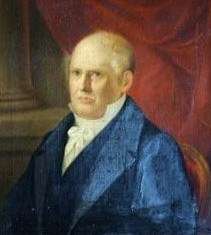León Ortiz de Rozas
| León Ortiz de Rozas | |
|---|---|
 portrait of León Ortiz de Rozas | |
| Personal details | |
| Born |
April 11, 1760 Buenos Aires, Argentina |
| Died |
August 15, 1839 (aged 79) Buenos Aires, Argentina |
| Resting place | Cementerio de la Recoleta |
| Nationality | Argentine |
| Spouse(s) | Agustina López de Osornio |
| Occupation | farmer |
| Profession | militia |
| Signature |
|
| Military service | |
| Allegiance |
|
| Service/branch | Spanish Army |
| Years of service | 1767-1809 |
| Rank | Captain |
| Battles/wars |
Conquest of the Desert British invasions of the River Plate |
León Ortiz de Rozas (April 11, 1760 – August 15, 1839) was a Spanish military and politician. He served as Commander in the military expeditions against the Indians during the Viceroyalty of the Río de la Plata.[1]
Biography
Rozas was born in Buenos Aires, son of Captain Domingo Ortiz de Rozas y Rodillo, born in Sevilla and Cathalina de La Cuadra, born in the city and belonging to a noble family of Basque and Creole origin.[2]
He began his military career in 1767 as a Cadet in the Infantry Battalion, then served in the Compañía de Granaderos with the rank of Sublieutenant. And he was promoted to Lieutenant on March 18, 1789. Some years later he reached the rank of Captain,[3] serving in the Regimiento Fijo de Buenos Aires.[4]
In 1785, Ortiz de Rozas was taken prisoner by the tribes of the Pampas. He was captured on January 26, of that year and freed September 16, 1786.[5]
He and his family participated in the defense and reconquest of the city against the English invaders.[6] He retired from the army in 1809, after forty-two years of active service.[7] Ortiz de Rozas was also a member of the Cabildo de Buenos Aires, where he served as regidor of the city.[8] In 1814 he held the position of interim alcalde and was appointed as supervisor of the weekly draws of the national lottery.[9]
León Ortiz de Rozas married September 30, 1790 in Buenos Aires to Agustina López de Osornio,[10] daughter of the rancher Clemente López de Osornio and María Manuela de Rubio. They had twelve children Juan Manuel, María Dominga, Gregoria, Andrea Mercedes, Prudencio, Gervasio José, María, Juana, Benigno, Manuela, Dominga Mercedes and Martina Agustina.[11]
Through his mother, Ortiz de Rozas descended from the first conquerors of the Río de la Plata and Paraguay, one of them was Domingo Martínez de Irala, born in Gipuzkoa.[12] He died on August 15, 1839 in Buenos Aires, being buried with military honors in the Recoleta Cemetery.[13]
References
- ↑ Las ideas políticas de Juan Manuel de Rosas. Arturo Enrique Sampay.
- ↑ Historia de la confederacion argentina:. Adolfo Saldías.
- ↑ Arqueología e historia en la colonia espańola de Floridablanca, Patagonia. María Ximena Senatore.
- ↑ Rosas, "el gran americano". Instituto Nacional de Investigaciones Históricas Juan Manuel de Rosas.
- ↑ La Patagonia:. José Miguel Yrarrázaval Larraín.
- ↑ Las dificultades de la historia científica y El "Rosas" del Dr. E. H. Celesia. Julio Irazusta.
- ↑ Perdón, Juan Manuel!: crónica de un regreso. Eugenio P. Rom.
- ↑ Acuerdos del extinguido Cabildo de Buenos Aires, Volume 6; Volume 44. República Argentina.
- ↑ Notas sobre el origen y desenvolvimiento de la Lotería de Beneficencia Nacional. Lotería de Beneficencia Nacional y Casinos (Argentine Republic).
- ↑ Matrimonios 1747-1796. Catedral de Buenos Aires.
- ↑ Rozas: ensayo histórico-psicológico. Lucio V. Mansilla.
- ↑ Revista, Volume 71. Círculo Militar (Buenos Aires, Argentina).
- ↑ Registro oficial de la provincia de Buenos Aires. Buenos Aires Province.